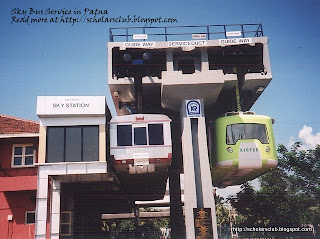Skybus a solution to India's transport problems
"Skybus is the story of Indian industry and entrepreneurs coming together to produce a unique thing,"
Why Sky Bus is an ideal solution according to KRC:
Follows the existing roads- but does not take road space- and be as flexible as a bus
Have rail based mass transit capacity, same as existing rail metro
Does not divide city while providing integration along its alignment
Be derailment and collision proof- with NO CAPSIZING of coaches- so that there can never be loss of life
Be free from vandalism
Noise free and pollution-free
Non-invasive -requiring the least amount of scarce land space- and not come in the way of development.
Virtually relegated to oblivion for seven long years, the Konkan Railway Corporation (KRC) has now invited global expression of interest for its "innovative and prestigious" sky bus project.
Stating that "feasibility of (sky bus) technology has been demonstrated by conducting real life trials up to speeds of 70kmph on test track at Goa (India)," the KRC's notice inviting global expression of interest (GEoI) has invited interested parties to submit their request for qualifications (RFQ) for "further development of the technology and its commercial deployment on revenue sharing or similar model."
Interested parties are required to submit their RFQs by December 10, 2010.
"Sky bus technology, which has been developed by Konkan railway, is an innovative, environment-friendly and cost effective alternative rail based transportation system.
It offers better speed, greater route flexibility and comfortable urban travel. Its construction is economic and faster requiring minimal land and at the same time creates additional space," says a press note issued by KRC's chief public relations officer, Siddheshwar Telugu.
Further stating that the KRC has also been granted various patents in India and abroad for sky bus technology and its sub-systems/components, the notice inviting GEoI claims that the "unique features of sky bus technology promise tremendous business potential as an alternate urban transportation system for medium and large cities."
It may be recalled that the sky bus project was inaugurated on October 15, 2003 at Margao by the then railway minister Nitish Kumar. Ironically, after a series of trials on the 1.6km test track, the 50cr project suffered a setback when, on September 25, 2004, its suspended coach hit several columns killing one staffer -- mechanical engineer T Balu- and injuring four others. The incident brought to the fore serious concerns regarding public safety following which the project was grounded.
Salient features of the Sky Bus
How sky Bus works ?
Heavy 52/60 kilograms /metres rails placed at standard gauge floating in elastic medium and damped by inertia of measured mass held in a 8 metres X 2metres box enclosure, supported over a 1m diameter. columns spaced at 15 metres and located at 15 metres distance from each other, in the divider space in between lanes on a road- way, at a height of 8metre above road surface- provides the support and guidance for powered bogies which can run at 100 kmph, with the coach shells suspended below, carry passengers in air conditioned comfort, can follow existing road routes, while existing traffic on roads continue.
Aesthetic and eco-friendly, the Sky Bus can never derail, capsize nor collide- by design as well as by construction, hence is safer than existing rail-based system.
With no signaling and having no points and crossings, it is a unique mass-transit system, which can be put up within two years in any crowded & congested city.
Sky Bus metro falls under tramway category, under Art 366(20) of Constitution of India, since it operates along existing roadways and within municipal limits, hence excluded from Indian railway act.
--------------------------------------------------------------------------
The Skybus does not really need a driver or an operator. When the Skybus approaches a station, it is supposed to slow down by itself and stop. The brake is only for emergency usage. In this case, the Skybus did not slow down, and the Control room threw the emergency brake which resulted in the accident.
The accident happened on the 1.5 km test track in Goa. Each part of the Skybus was made in India by contractors and corporate's like the Tatas and Essar provided construction material free or at nominal rates to Konkan Railway for building the test track in Goa. The KRC has spend Rs 50 crore on this project at the 1.5 km testing laboratory at the Margao railway station, in Goa, as the new technology awaits a nod for its commercial use. "Skybus is the story of Indian industry and entrepreneurs coming together to produce a unique thing," Rajaram had said. Till then, the unique Indian innovation awaits the nod from the Indian law makers, on whether it will be best suited for commercial use or it will just rust out on the Goa tracks.
View Sky Bus Pictures/ Wallpaper/ Photos....................CLICK HERE
The accident happened on the 1.5 km test track in Goa. Each part of the Skybus was made in India by contractors and corporate's like the Tatas and Essar provided construction material free or at nominal rates to Konkan Railway for building the test track in Goa. The KRC has spend Rs 50 crore on this project at the 1.5 km testing laboratory at the Margao railway station, in Goa, as the new technology awaits a nod for its commercial use. "Skybus is the story of Indian industry and entrepreneurs coming together to produce a unique thing," Rajaram had said. Till then, the unique Indian innovation awaits the nod from the Indian law makers, on whether it will be best suited for commercial use or it will just rust out on the Goa tracks.
View Sky Bus Pictures/ Wallpaper/ Photos....................CLICK HERE
Get Updates!
Subscribe to the Scholars club email newsletter to receive updates, freebies and exclusives:==>Help us to keep SCHOLARS CLUB running?


Post a Comment
PLEASE SUBMIT YOUR VALUABLE SUGGESTIONS TO GET PUBLISHED.